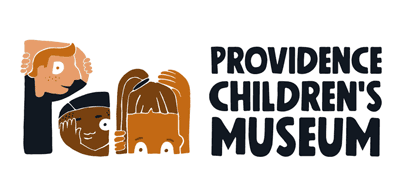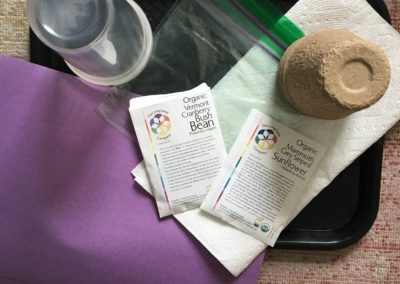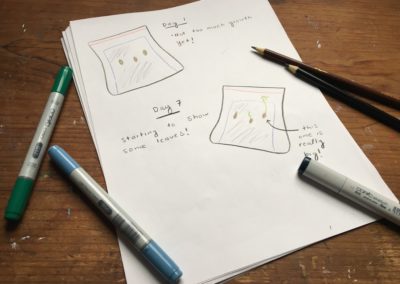How Does Your Garden Grow?
Developed by Karen Bryer, PCM Play Intensive 2021
(FOCUS: K-2; Science, Technology, Engineering, and Mathematics; Language and Literacy)
Most students know that plants need sunlight, water, and soil to grow, but what would happen if one of those elements were eliminated? In this lesson, students design an experiment to help answer that question.
Students will come to this with various experiences with growing plants and understanding their needs. You can find out what they know about seeds and growing plants and vegetables at home or at school by asking students to illustrate what might be needed to help a seed grow. This can give you a quick understanding of what students know and how much review may be necessary. It’s important for students to understand that plants grow best with adequate water, sunlight and soil. Many children’s books and videos can help to support this understanding, so sharing a few can be helpful before the activity.
Materials
- Seed (Lettuce, cucumber, and beans work well.)
- Water (Bottles of water work well for pairs of students.)
- Paper towel
- Cups
- Plastic baggies
- Small plastic containers, preferably clear
- Black construction paper, paper bags, or other materials to block sun (Encourage students to determine what to use on their own.)
- Plant Experiment Journals (one copy for each student)
Additional Details:
- Sprouting the seeds on a moist paper towel in a plastic bag or container can assure students that growth has started before the experiment. This is included in the journal as part of the first lesson which can include explanation of the experiment and encouraging students to begin to develop their plan.
- The materials listed are a minimal starting point, but students should be encouraged to think of additional materials that may be helpful for their design.
- This challenge is set for each individual student to try to plan an experiment alone. It may be best to let it run over two weeks for observations, which can take place every other day.
Set Up
After an initial review of what is needed for plant growth, use the remaining lesson time to start the sprouting of some seeds. It’s important that students see that growth of the seeds has started before their experiment starts. Most seeds will sprout after a few days. Using a paper towel and water, students can sprout the seeds in a plastic bag or container. Taping the plastic bag to a window can hurry the process but too much sun/heat can dry out the paper. Checking on the seeds and the experiment every few days is a good chance to demonstrate the expectations for recording observations in students’ science journals.
Explain the challenge to students and have them begin to think of what element they may wish to eliminate for their experiment. Highlighting experiment design, prediction, and observation can help students understand these science concepts.
Student’s Job
Students will plan an experiment to prove plants need water and sunlight to grow.
- Have students begin to think of what their experiment will involve as they wait for seed sprouting to begin. Have students record and diagram their plan in their journal so they are ready to follow it to set up their experiment.
- Students should determine where they will place their plant for the next two weeks. Observations should be done every other day or so, and students should record their observations in their science journal with measured data when possible. If students have access to a device, the Stop Motion app or a similar simple photo tool can be used for recording and labeling the plant’s growth.
- Students can write a conclusion of their findings after two weeks and/or share and compare their observations with other students.
Teacher’s Job
The teacher’s role is to provide students guidance during the planning process to ensure their plan meets the requirements and to support students as they execute their experiment and observe and record findings. It is important that students take ownership of the ideas behind the experiment.
The teacher can guide measurement and observations and the discussion and sharing of findings with the class as a whole. Teachers can create a chart to introduce plant vocabulary and then record reports of student observations. The chart can help students see similarities and differences in growth. Think about recording number of leaves, height, root growth, color, etc. but try to elicit these comparisons from students, i.e., “How can we tell which plants are growing best?” Highlight how scientists rely on data to make comparisons.
Through this guidance and observation, you should be able to gage students’ understanding of the concepts involved in conducting an experiment, producing data from the experiment, and making comparisons/drawing conclusions from data.
Standards Alignment
NEXT GENERATION SCIENCE STANDARDS: ECOSYSTEMS
2-LS2-1: Plan and conduct an investigation to determine if plants need sunlight and water to grow. Plan and conduct an investigation collaboratively to produce data to serve as the basis for evidence to answer a question.
COMMON CORE STATE STANDARDS.ELA-LITERACY.WRITING.2.7
Participate in shared research and writing projects (e.g., read a number of books on a single topic to produce a report; record science observations).
COMMON CORE STATE STANDARDS.ELA-LITERACY.WRITING.2.8
Recall information from experiences or gather information from provided sources to answer a question.
COMMON CORE STATE STANDARDS.ELA-LITERACY.SPEAKING & LISTENING.2.5
Create audio recordings of stories or poems; add drawings or other visual displays to stories or recounts of experiences when appropriate to clarify ideas, thoughts, and feelings.
Connection to previous work?
This activity can be connected to a larger unit on interdependent relationships in ecosystems and serves as a good introduction to a unit on pollination. Alternatively, it can remain a standalone experiment over the course of a few weeks.
Prepare/ Background Info
This lesson is designed for students to design and conduct an experiment and practice predictions and observations. It gives students a chance to use measurement tools appropriately. Reporting the findings to the class is an opportunity for students to make comparisons and draw conclusions.
Play to Notice
How well can students work independently to make and carry out a plan?
Content Matter to Notice
Do students use the science vocabulary correctly and regularly in their journaling?
SEL to Notice
Students can become very attached to their plants and become emotional if they are not thriving. You may wish to monitor this and allow students to alter their experiment early and observe the changes that it may bring.



0 Comments